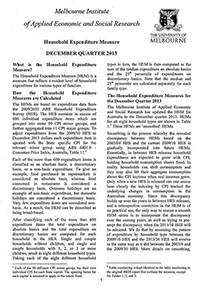Household Expenditure Measure (HEM)
Report Description
 The Household Expenditure Measure (HEM) is a measure that reflects a modest level of household expenditure for various types of families. The first HEM was produced for 2011 Q1. Since then there have been quarterly updates, with a major change being the 2011 Q3 update when the 2009/10 Household Expenditure Survey (HES) was used for the first time.
The Household Expenditure Measure (HEM) is a measure that reflects a modest level of household expenditure for various types of families. The first HEM was produced for 2011 Q1. Since then there have been quarterly updates, with a major change being the 2011 Q3 update when the 2009/10 Household Expenditure Survey (HES) was used for the first time.
To produce the HEM, all 600+ expenditure items in the ABS Household Expenditure Survey (HES) are classified as absolute basics, discretionary basics and non-basics. The HEM is taken as the median spend on absolute basics plus the 25th percentile spend on discretionary basics. A rough idea of this classification is that absolute basics captures almost all food, children’s clothing, utilities, transport costs, and communications. Discretionary basics on the other hand includes take away food, restaurants, confectionary, alcohol and tobacco, adult clothing, childcare, and entertainment. Examples of non-basics are luxury services (e.g. gardeners) and overseas holidays. Rents and mortgage payments aren’t included by design, as the HEM is meant to be a net-of-housing costs measure. Every quarter the HEM is uprated using state-specific values for each of the 90 or so CPI minor groups.
How the HEM Compares with the HPL
The HPL is based on a household survey of New York City families in the 50s, updated in the 70s (using Australian household survey data) and has since been updated using national account data. The HPL is calculated for a family of two adults and two children. It is a single number. That number gets multiplied by a weight, or fraction, to get the HPL for other families. The HEM is built from scratch on expenditure data. It looks at what families actually spend. It also treats each family type separately. It is found that the difference in the HEM between a couple with 1 child and a couple without dependents is much larger than the difference in the HEM between a family with 2 children and a family with 1 child.
As part of the original research the HEM was benchmarked against, for instance, the Henderson Poverty Line, ASFA Retirement Standards, NewStart Allowance, and the Age Pension. When compared with the HPL the HEM is more generous towards couples and couples with up to 1 child, and less generous towards singles and single parents. For couples with 2 children the HPL and HEM are very close, even though they are derived at in completely different ways.
Sample HEM Update Report March Quarter 2014 (* actual numbers removed in the sample)
Subscription Details
The Melbourne Institute produces the HEM which is distributed through RFi Rountables who also handle subscriptions. Any queries related to the HEM itself can be directed to the contacts at the Melbourne Institute. Any queries related to access to the HEM should be directed to RFi Roundtables.
Subscription Enquiries
-
Dane Binney
RFi Roundtables
Level 13,
92 Pitt Street
Sydney NSW 2000
Australia.
P +61 2 9146 5950
F +61 2 9267 2470
email: [email protected]
HEM Contacts
Dane Binney is Senior Consultant – RFi Benchmarking and Roundtables and is responsible for the dissemination of the HEM to subscribers.
His contact details are:
RFi Roundtables
Level 13,
92 Pitt Street
Sydney NSW 2000
Australia.
Phone: +61 2 9146 5950
Fax: +61 2 9267 2470
email: [email protected]
Guyonne Kalb, Professorial Research Fellow at the Melbourne Institute, is responsible for producing the quarterly HEM for delivery to RFi.
Her contact details are:
Melbourne Institute of Applied Economic and Social Research
Faculty of Business and Economics
The University of Melbourne Vic 3010
Phone: +61 3 8344 2095
Fax: +61 3 8344 2111
email: [email protected]
